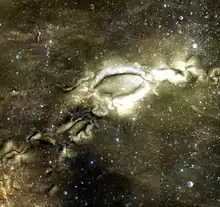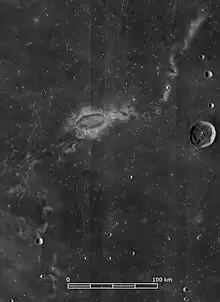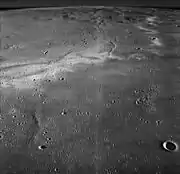Reiner Gamma
Reiner Gamma (γ) is a geographical feature of the Moon known as a lunar swirl. It is one of the most visible lunar swirls from Earth, visible from most telescopes.[1] It was originally thought to be a lunar highland, but scientists eventually realized that it cast no shadow on the moon.[2]
 UV-VIS false color albedo image of the Reiner Gamma albedo feature. | |
| Coordinates | 7.5°N 59.0°W |
|---|---|
| Diameter | 70 km (43 mi) |
| Eponym | Reiner crater |
Origin
The origin of Reiner Gamma—like other lunar swirls—is not completely understood. It is associated with a localized magnetic field, but not with any particular irregularities in the surface. Similar features have been discovered in Mare Ingenii and Mare Marginis by orbiting spacecraft.[3] The feature on Mare Ingenii is located at the lunar opposite point from the center of Mare Imbrium. Likewise the feature on Mare Marginis is opposite the midpoint of Mare Orientale. Thus one hypothesis is that the feature resulted from seismic energies generated by the impacts that created these maria. However, no such lunar mare formation is on the opposite side of the Moon from Reiner Gamma.
Location and Features

Reiner Gamma is located on the Oceanus Procellarum, west of the crater Reiner. Its center is located at selenographic coordinates 7.5°N 59.0°W. It has an overall length of about 70 kilometres. The feature has a higher albedo than the relatively dark mare surface, with a diffuse appearance and a distinctive swirling, concentric oval shape. Related albedo features continue across the surface to the east and southwest, forming loop-like patterns over the mare.
The central feature of Reiner Gamma resembles the dipolar formation created by iron filings on a surface with a bar magnet on the underside. Low-orbiting spacecraft have observed a relatively strong magnetic field associated with each of these albedo markings. Some have speculated that this magnetic field and the patterns were created by cometary impacts. However the true cause remains uncertain.
Reiner Gamma's magnetic field strength is approximately 15 nT, measured from an altitude of 28 km. This is one of the strongest localized magnetic anomalies on the Moon.[4] The surface field strength of this feature is sufficient to form a mini-magnetosphere that spans 360 km at the surface, forming a 300 km thick region of enhanced plasma where the solar wind flows around the field.[5] As the particles in the solar wind are known to darken the lunar surface, the magnetic field at this site may account for the survival of this albedo feature.[6]
In early lunar maps by Francesco Maria Grimaldi, this feature was incorrectly identified as a crater. His colleague Giovanni Riccioli then named it Galilaeus, after Galileo Galilei. The name was later transferred northwest to the current crater Galilaei.
 Lunar Reconnaissance Orbiter Wide Angle Camera image of Reiner Gamma.
Lunar Reconnaissance Orbiter Wide Angle Camera image of Reiner Gamma. Oblique view from Lunar Orbiter 2, with the Marius Hills in the background.
Oblique view from Lunar Orbiter 2, with the Marius Hills in the background.- Beginning with a full-globe view of the lunar near side, the camera flies to a close-up, increasingly oblique view of the lunar swirl.
 Reiner and Marius areas
Reiner and Marius areas
References
- "Lunar Swirls". Retrieved 18 April 2017.
- "Bubble Bubble - Swirl and Trouble". Retrieved 18 April 2017.
- Huddleston, Marvin (October 29, 2009). "LUNAR SWIRLS, MAGNETIC ANOMALIES, AND THE REINER GAMMA FORMATION". The Rambling Observer. Retrieved 7 December 2019.
- Richmond, N.C.; et al. (2003). "Correlation of a Strong Lunar Magnetic Anomaly with a High-Albedo Region of the Descartes Mountains". Geophysical Research Letters. 30 (7): 48. Bibcode:2003GeoRL..30.1395R. doi:10.1029/2003GL016938. hdl:10150/623384. S2CID 128822762.
- Wieser, Martin; et al. (March 2010). "First observation of a mini-magnetosphere above a lunar magnetic anomaly using energetic neutral atoms". Geophysical Research Letters. 37 (5): L05103. arXiv:1011.4442. Bibcode:2010GeoRL..37.5103W. doi:10.1029/2009GL041721. S2CID 117346419.
- L. L. Hood; C. R. Williams (1989). "The Lunar Swirls - Distribution and Possible Origins". Proceedings 19th Lunar and Planetary Science Conference. Cambridge University Press/Lunar and Planetary Institute. Bibcode:1989LPSC...19...99H.
External links
- Phillips, Tony (2006-06-26). "Mysterious Lunar Swirls". Science@NASA. Archived from the original on 2006-06-30. Retrieved 2006-06-27.
- Overexposed 35mm Nikon camera image of Reiner Gamma from Apollo 17: AS17-158-23895
- Lunar Orbiter 4 image showing Reiner Gamma in upper left: IV-157-H1